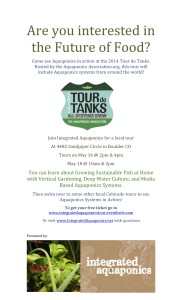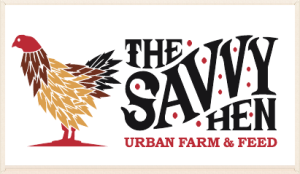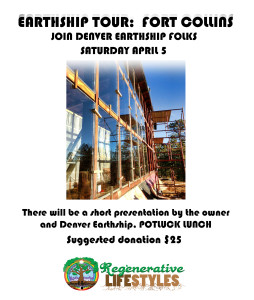Looking for a PDC in Colorado this summer? There’s a residential course in Woodland Park, CO, taking place June 15-28, 2014. Check out the link to the gorgeous flyer above! Main instructors are Peter Bane, Marco Chung-Shu Lam, and Becky Elder. Guest instructors will also join the course. Cost $1500. Fees include camping, healthy and delicious food, and all course materials, including The Permaculture Handbook, Peter Bane’s new book. The course is taking place at Aspen Valley Ranch, and is the first residential course being offered by Pikes Peak Permaculture. “Get inspired, get certified!”
Author Archives: Kristin
Aquaponics Tour De Tanks, Boulder, May 16 & 18
From Avery Ellis of Integrated Aquaponics and Colorado Greywater:
There will be a tour at my house to see my aquaponics systems in action, my geodesic dome, and other fun permaculture science toys and connections to be made. The tours at my house will be on May 16 @ 2pm & 4pm and May 18 @ 10am & 2pm. There are other local tours in the Boulder area from some of my past students. The attached flier is for the tours at my house only, and I created a registration page for people to get their free tickets at integratedaquaponicstour.
An update from Avery on Colorado Greywater law:
The Colorado Greywater law is developing slowly but surely. We finally have the state plumbing board in the conversation and this Friday morning will be our first workgroup to include the plumbing board and the dept of public health at the same table. I will be there with a group of permies to represent simple systems and the need for the law to be inclusive of many possible solutions. Please let me know if you have interest in helping with the development of this law, as I could use all the help I can get. And stay tuned for more info in the coming months.
Chicken Keeping Class at The Savvy Hen, Boulder, Sat. 4/26
From The Savvy Hen:
Chicken Keeping 101
Saturday April 26th, 4-5:30pm
This has been a popular class for us this spring! We’ll share lots of great information for the beginning chicken keeper or anyone who is thinking about keeping chickens. We’ll cover the basics of starting chicks, keeping adult hens, necessary equipment, nutrition, health concerns, and much more. We’ll have time for questions too!
$10 per person.
* This class is almost full, contact us soon by email or phone to sign up!
Permaculture Design Course in Durango, May-June 2014
PDC at Sunrise Ranch starts today, 4/2/14
From Sunrise Ranch:
Course Details
Dates and Times
April 2-April 11, 2014
Classes run daily from 8:45am- 5:30pm except on days with evening sessions when we end at 9:00pm. Lunch is served from 12:15 -1pm. (There will be some night sessions from 7:30-9pm, in which case dinner will be provided from 6:15-7pm. TBA)
There will be a combination of class time, field work and design work.
Tuition and Registration
Tuition ($1050 before March 31 and $1150 after) includes official design course T-shirt and an internationally recognized certificate of completion. Tuition does not include meals. Accommodation fees are: $400 for camping, and $550 for a bed in a dorm room. Commuter fees (if you choose to partake in all meals during course) are $300. Register online or call 970-679-4200 or 877-786-0078
For more information contact Internship Registrar Keahi Ewa at keahi at sunriseranch dot org.
Click here for more information about internship opportunities at Sunrise Ranch.
2014 Neighborhood Agriculture Grant
From Branch Out Cider, LLC:
Branch Out Cider, LLC is pleased to announce the 2014 Neighborhood Agriculture Grant. Grants up to $500 will be awarded to support neighborhood agriculture projects — such as planting some apple trees, sharing a compost bin, front yard gardens, etc. To apply for the grant, please visit: www.branchoutcider.com
The company will award grants up to $500 for Neighborhood Agricultural projects based on the following criteria:
1. Agricultural project in a neighborhood
2. Engagement and participation of neighbors and community partners
3. Commitment to maintain the agricultural project year-after-year
The grant application rules are as follows:
1. Grant funds are for materials in support of the project
2. Project should be completed by September 1, 2014
3. All grant applications are due by April 30, 2014 at 11:59PM MST
Branch Out Cider makes (hard) apple cider from a collaboration of neighbors and their apples trees—the Community Orchard. The company values keeping agricultural production in our community to support our local economy while reducing the need to ship food from across the country.
For more information, please contact Aaron Fodge, aaron at branchoutcider dot com
http://branchoutcider.com/
Day 1 at Permaculture Voices, 3/13/14, Neil Bertrando, “Tree Systems in the High Desert”
Neil Bertrando, “Tree Systems in the High Desert”
Neil started his talk with a geographical and climactic depiction of the Great Basin of Nevada, where he lives and does his permaculture design work. The Great Basin climate is “BWks”, based on Köppen climate classification, meaning arid, cold, and summer dry. Most of the natural irrigation comes from melting snowpack. Central Asia has a similar climate in parts of India and Kazakhstan. Trees are not part of the landscape here, unless connected with water.
Neil’s analysis of the topography of the land showed broad, U-shaped valleys separated by north-south ranges, with alluvial fan complexes. On the topic of water, he emphasized the importance of knowing your water catchment and the location of aquifer recharge areas.
Roads have proven to be excellent water distribution conduits in the Great Basin. Neil points out that the optimal road location in his area is on terraces or alluvial fans on contour. He recommends avoiding the valley floor, as this is an important wildlife zone. Neil recommends the book, A Good Road Lies Easy on the Land… Water Harvesting from Low-Standard Rural Roads, by Bill Zeedyk. When designed well, roads can distribute and shed runoff to swales.
Regarding forestry, Neil discussed forest management as a tool for preventing soil erosion. One of the goals is headcut water erosion prevention. Preventing headcuts in the landscape will increase the water table in the area. Additionally, active harvesting needs to take place in woodlands to prevent a dense canopy. In the Great Basin, a forest that was allowed to grow to a dense canopy burned to the ground in one of the last major wildfires. Regular clearing will allow a grass understory to grow, which holds soils in place. With spacing between the trees, there is less chance that the entire forest will burn to the ground during a wildfire. A completely burned patch is a prime soil erosion area that will take more time to rejuvenate, versus an actively managed forest.
Neil emphasized the importance of using Yeomans Keyline Scale of Permanence for decision making.
Fencing and Subdivision are useful for helping plants and trees to get established in the landscape. Irrigation of plants and trees is necessary for establishment; Neil is moving toward planting where the water is already present. In his experience, when planting trees, everything wants to eat them. Good fencing and trunk protection will keep the young trees alive as they get established. Fencing is also great in that they catch windblown water and nutrients (snow, plant material). Once the trees are growing, you can use trees to build more fences, to plant more trees.
On the topic of soils, it is important to know soil depth to restrictive features, water holding capacity, and salts content. Neil had a question from the audience on how to get started with highly salted soils. He recommended starting with salt tolerant plants, and animals that can export those salts in the form of manures, etc. He compiled a list of salt tolerant plants for cold arid climates and posted it on permacultureglobal.com.
This write-up covers just a few basics of what he discussed; he had some great examples of forest plantings he designed and implemented in the Great Basin, planned based on the climate, geomorphology of the land, water catchment, and aquifer recharge zones.
Cheers to Neil on having the most impressive moustache at the conference!
Neil Bertrando’s site: RT Permaculture
Earthship Tour in Fort Collins, this Saturday, 4/5/14
From Regenerative Lifestyles:
The day is coming soon! Earthship Tour- Fort Collins!
We are still arranging transportation details, and will hopefully have a bus that can accommodate many people from Fort Collins to the mountains. There will be a short presentation by the owner and Denver Earthship, and a potluck lunch.
RSVP how many people will be joining. Here is the link to register and for suggested donation of $25,
http://denverearthship.com/
Accepting cash on the day of or donate what you can via link or paypal: denverearthship@gmail.com , nobody will be turned away.
Denver folks, we suggest to meet up at 9 at:
Alameda Station park n ride
499 S Cherokee St
Cherokee St & Alaska Pl
Boulder Folks, we are planning to meet at McGuckins parking lot near Brewing Market (on Folsom) in Boulder at 9am to arrange carpools. We will leave as close to 9:30 as possible in order to get to Mark Squibbs house (in Fort Collins) by 11. The address there is 114 S Sunset St, Fort Collins, CO 80521
We will gather and then head up the mountain to the Earthship from there, possibly in a bus. Returning around 5pm. Text or Call Robin at 808-446-2628.
Please bring water, warm clothes, a packed lunch or something to share for the journey.
Cheers!
www.regenerativelifestyles.org
Day 1 at Permaculture Voices, 3/13/14, Larry Santoyo “Urban Urgency”
Larry Santoyo, “Permaculture for Humanity: Moderating the Urgency of Urbanism”
Larry Santoyo, a permaculture teacher and designer from LA, brought images of his design work from urban locations around the world. He discussed how when he first learned permaculture, he thought he wanted to move from the city to the wilderness to start from the ground up and create his own place. So he did, moving from LA to the Pacific Northwest. And realized it was a terrible idea. In the process, though, he realized that “making urban centers more sustainable is how we directly preserve the wilderness.” In the words of Bill Mollison, he said, “If we lose our universities, we would lose nothing. If we lose our forests, we lose everything. ”
Larry has since returned to the urban setting, concentrating his work in LA. As Larry points out, we always have human ingenuity. Arts, science, culture, technologies, strategies. Think of biomimetic responses–how would nature do it? And a quote he is known for, “We don’t do permaculture design, we use permaculture design.”
Larry continues, Nature starts small, with small successful arrangements. These can be duplicated, and replicated–solutions multiply. Form hundreds of millions of small working groups. These groups will work together to meet each others’ needs. Surplus resources can be used toward unmet needs. “Be proud contributors to the community! Not just consumers.”
Larry had a question from the audience, “How do you define wealth?” To which he answered, “I think every community will define that for themselves. Try to be valuable rather than try to be wealthy.”
And probably my favorite quote from Larry, and the conference as a whole, “I think that one day we will be so embarrassed that we had to have a fucking conference to talk about doing the obvious. Let’s never talk about this again. “
When working within the community, Larry stresses, “the person that gets listened to is the person that is quiet, confident, and speaks from experience. ”
In a particularly violent village in Haiti, Larry and a team visited to address the issue of human waste and sewage in the streets. A previous group of permaculture designers had gone to the village, applying a solution, composting toilets, without thinking through the problem. Composting toilets were NOT the solution, in fact, they were spreading cholera, as people carried their waste to composting piles. Instead, Larry’s team built canals to channel sewage away from where people were standing in the village. Larry stresses, the methodology is the same, but the programming, output and design is different.
In another village that Larry visited, a 1600s colonial town in high altitude Mexico, he felt he was more the student than the teacher. This is a very large town, with its own bank, and agricultural trials using methods from all over the world. Yet the people had their traditional culture intact. They are interested in what people are doing around the world, and if they believe its something that might work for them, they try it out. One of the main crops in the area is coffee. If a farmer wants to grow coffee, the bank goes to the property and surveys 127 bird species and other biological indicators to make sure coffee growing will be successful, and that the bank’s investment will be safe. Let’s learn from these folks!
Thanks to Larry for some of the greatest stories and quotes from the conference.
Larry Santoyo leads EarthFlow Design Works and City of Angels Permaculture Academy.
Day 1 at Permaculture Voices, 3/13/14, Joel Salatin “Fields of Farmers”
Joel Salatin, farmer at Polyface Farms and cultivator of charisma, opened the conference with “Fields of Farmers”. He discussed farming as a business and developing working models for regenerative farms. In Joel’s words:
Every place has an asset and a liability. Every person has talents and skills to bring to the table. Until we have two salaries from our enterprise, it is not a business, and it is not sustainable. In the next 15 years, 50% of America’s farmland is going to change hands. Old people [can] leverage their experience on youthful energy and enthusiasm [to develop the next generation of farmers]. When the young people can’t get in, the old people can’t get out.
So what are some of the impediments to entry?
1) Capitalization/cost of land. 2) Lack of information. 3) “No money in it.”
How do we create farms that are magnetic to young people? First message to the group: we have not even begun to leverage the resources under our feet. There is not a piece of property in the world that is not fully developed, ecologically speaking.
At Polyface Farms, gross is $8000/acre, versus neighbors who are grossing $250/acre. How? Polyface is not just cattle–they also have pigs, chickens, and rabbits, on 100 acres. BELIEVE you can do more with the property that is being done. Implement portable infrastructure. You do not have to own the land when everything is portable.
Side note: the government is trying to separate Concentrated Animal Feed Operations (CAFO) from produce–because of poop–Joel calls this the “poop paradigm”.
Cornell University performed a study in New York state on how much farm land has been abandoned in the last 15 years. The result? 3.1 million acres. One of Joel’s interns from Ithaca, NY, had 3 unsolicited offers within 30 days of returning to NY, asking him to farm a total of 1000 acres of land. Find these opportunities! People who own land are seeking those who wish to work it.
Farm equity is in the management and the customers. Know how to make a beautiful landscape, a place that people want to come and visit. Let’s let permaculture design show order that is aesthetically penetrating! Have a place to put unfinished projects! [Peter Bane’s Garden Farming Pattern Language, Pattern #56: Zones of Accumulation] Look at your farm from a food writer’s or National Geographic eye. Equity is portable, and in information and management, you have wiggle room. You have got to create value added on your place. Leverage your resources. If you are not putting 2000 hours per year on your tractor, you need to rent one.
Farm with 1) the belief that the farm is not anywhere near its potential; 2) portable infrastructure, information and management; 3) value-added, stacked enterprises. You need marketing. Go with a last-born child; 80% of marketers are last-born; you need a “gregarious, storytelling schmoozer.” These things have to be done to make a magnetic, profitable farm. Multi-generationalism, with at least two salaries, is necessary for a regenerative farm with a continuity plan. Remember: production, processing, accounting, distribution, AND marketing.



